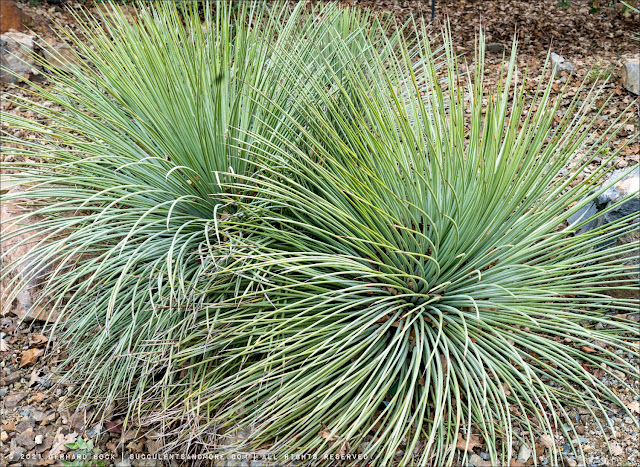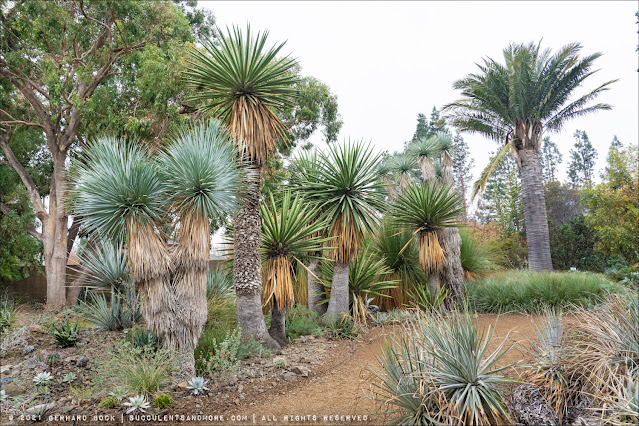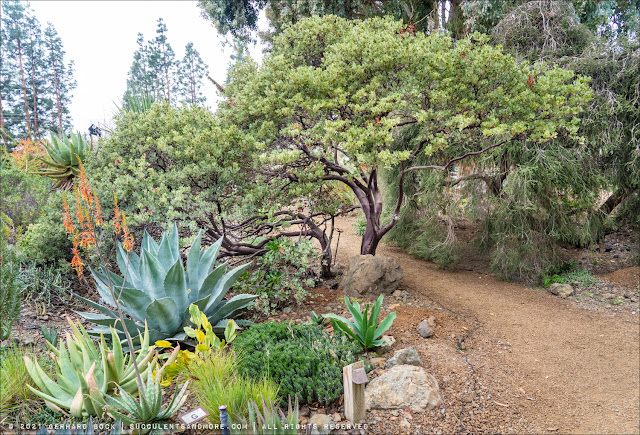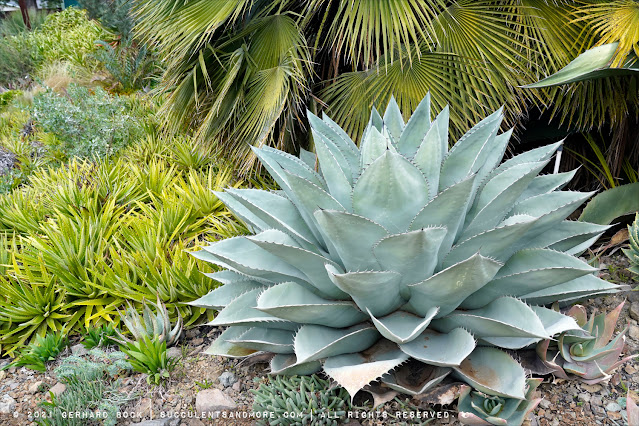Ruth Bancroft was 63 years old when she started her dry garden on three acres surrounding her home in Walnut Creek, California. At the time, she was often asked why she would embark on such a big project at her age when it was more than likely that she would never see the plants grow to maturity.
This was her reply: “Well, who cares if I’m around or not? Someone will be around. And if I don’t plant it then nobody will get to see it.”
I think of that every time I visit the Ruth Bancroft Garden. That—and the fact that Ruth lived another 47 years. She did get to see her garden mature after all, and she inspired thousands of gardeners with her vision and perseverance.
Ruth died on November 26, 2017 at the age of 109. Her legacy lives on and, if anything, is more vital today than ever before. Garden curator Brian Kemble, who has been with the garden for an impressive 41 years, and assistant curator Walker Young, who joined the team nine years ago, have transformed the garden from its humble beginnings into a destination known around the world.
I've been coming to the Ruth Bancroft Garden for a long time now, and it's getting better and better: The range of plants in the collection is wider than ever, and the way they're presented is more dramatic and impactful. Brian Kemble with his encyclopedic botanical knowledge and Walker Young with his flair for artistic design have elevated the garden to a level Ruth could not possibly have dreamed of.
This past Saturday, I spent a wonderful morning at the Ruth Bancroft Garden and took so many photos that I decided to spread them out over three posts, one every Monday between now and Christmas.
Let's get started!
 |
| Multi-trunked Yucca rostrata at the entrance to the garden. The metal-clad building is the new Visitor and Education Center. |

|
| A particularly beautiful specimen of Agave ovatifolia outside the Visitor and Education Center |
 |
| Offsets from an Agave filifera that spontaneously became variegated (more info on this plant on RBG's Tumblr) |
As part of the construction of the new Visitor and Education Center a few years ago, the entry garden underwent a complete renovation. Assistant curator Walker Young and his crew brought in tons (literally) of soil and rocks to create mounds of varying height, allowing smaller plants to be placed in such a way that they can be seen and appreciated more easily.
 |
| Agave utahensis var. nevadensis |
 |
| Agave utahensis var. eborispina |
 |
Lachenalia punctata, another wonderful member of this bulb species from South Africa. Gotta look for a source!
|
The RBG's signature Agave franzosinii were replanted on top of new mounds:
 |
| Agave franzosinii... |
 |
| ... showing the "lost wax" the plants at the RBG are known for. The darker blue spots are caused by the powdery coating rubbed off as the leaves develop. |
Venturing deeper into the garden...
 |
| Agave striata |
 |
| Yucca grove near the Visitor Center |
 |
| There's nothing quite as graphic as a tapestry of opuntia spines |
 |
| Green pads and red fruits: opuntias effortlessly deliver all the right Christmas colors |
 |
| Flowering manzanita and a bloomed-out agave carcass make for a startling contrast |
 |
| Dudleya (brittonii?) and Ferocactus (wislizeni?) |
 |
| Aloe rubroviolacea (Yemen, Saudi Arabia) close to flowering |
 |
| Aloe marlothii (South Africa) not far behind |
 |
| Aloidendron dichotomum, not even 5 ft. tall but a perfectly formed specimen already, and Aloe pearsonii × distans, a Brian Kemble hybrid (from the same seed batch as 'Hellskloof Bells') |
 |
| Unidentified aloe and a remarkable crested Aeonium arboreum |
 |
| Agave mitis 'Chocolate Edge' done blooming (more info in this post). It did set some seeds, and I'm sure Brian Kemble will collect them. |
 |
| These Cereus cacti sprouted on their own on the trunk of this Butia palm20+ years ago. Eventually, they'll get so heavy that they'll fall off, but for now, they're holding on. |
 |
| One of my favorite spots in the garden. The small tree is a 'Ruth Bancroft' manzanita (Arctostaphylos 'Ruth Bancroft'), a hybrid of unidentified parentage that spontaneously emerged in the garden many years ago. The large agave on the left is Agave ovatifolia, and the flowering aloe is Aloe fosteri. |
 |
| The miniature "tree" is in the front is Crassula sarcocaulis, a jade tree relative with smaller leaves |
 |
| Grevillea 'King's Fire' (left) is clearly happy in this spot |
 |
| One of many agaves flowering at the RBG at any given time |
 |
| Agave ovatifolia in its final stage of life after flowering |
 |
| Another Agave ovatifolia nearby is in its prime |
Below are the links to part 2 and part 3.
RELATED POSTS:
© Gerhard Bock, 2021. All rights reserved. To receive all new posts by email, please subscribe here.



























The garden is gorgeous. One day will make it there. The crested aeonium is stunning. The dark red rosettes looking like roses. I like Ruth's philosophy about starting the garden so late. They same the about trees. The amazing thing about Ruth's garden, but unfortunately not many others, is that it will always be saved from the developers shovel.
ReplyDeleteThe RBG is safe from development. Which is amazing, considering it's in a prime residential neighborhood.
DeleteI haven't been to the garden since the end of May-how did that happen ?? I'll enjoy this armchair visit and be sure to head down there in January..
ReplyDelete
DeleteTime flies. I hadn't been all summer either! Let's meet up in January!
It's such a fabulous garden. As taken as I was by various species I'm not familiar with, I went a little ga-ga over the crested Aeonium arboreum.
ReplyDeleteI swear, every time I visit I notice plants I'd never seen before! I love that sense of discovery.
DeleteToujours un réel plaisir de visiter ce magnifique jardin et découvrir ses allées richement plantées. Une source d'inspiration pour mon jardin qui a un climat similaire. La comparaison s'arrête là , mon jardin étant minuscule. Encore merci pour cette visite. Hâte de voir la suite.
ReplyDeleteGérald, my garden is very small, too, so I know exactly what you mean! I'm inspired every time I visit the Ruth Bancroft Garden. I wish had room (and $$) to add larger rocks!
DeleteMerci de lire mon blog et de laisser un commentaire. Il me fait plaisir de savoir que j'ai des lecteurs en France !
I normally dislike crested plants, but as the others have said that Aeonium arboreum is crazy cool! Thanks for this most wonderful Christmas gift of images from one of my favorite gardens.
ReplyDeleteIt turns out the crested aeonium was given to the garden by another reader when she moved away from California! She emailed me to let me know. I love that!!!
DeleteJudging by your photos the garden does indeed "look better and better". I hope to get back there for a visit if this Covid thing ever settles down. The stunner for me is the 'Vanzie'(?) form of ovatifolia in photo 2. Perfection!
ReplyDeleteYESSS! That 'Vanzie' is phenomenal. I have one, in the back yard, and it's beginning to look like that, which makes me very happy.
DeleteI hope you'll make it up our way next year!